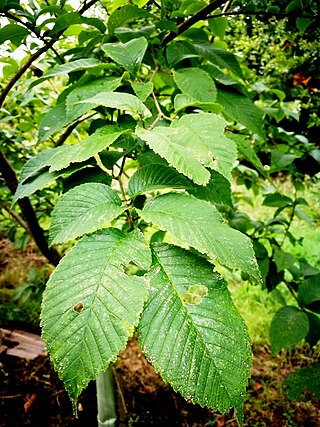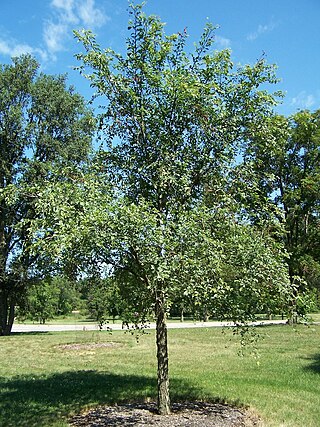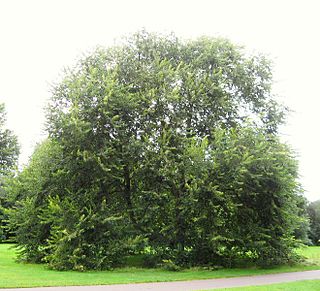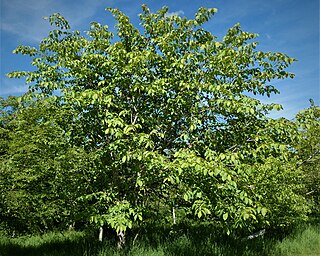
Ulmus wallichianaPlanch., the Himalayan elm, also known as the Kashmir elm and Bhutan elm, is a mountain tree ranging from central Nuristan in Afghanistan, through northern Pakistan and northern India to western Nepal at elevations of 800–3000 m. Although dissimilar in appearance, its common name is occasionally used in error for the cherry bark elm Ulmus villosa, which is also endemic to the Kashmir, but inhabits the valleys, not the mountain slopes. The species is closely related to the wych elm U. glabra.

Ulmus davidiana var. japonica, the Japanese elm, is one of the larger and more graceful Asiatic elms, endemic to much of continental northeast Asia and Japan, where it grows in swamp forest on young alluvial soils, although much of this habitat has now been lost to intensive rice cultivation.
Ulmus bergmannianaC.K.Schneid., commonly known as Bergmann's elm, is a deciduous tree found across much of China in forests at elevations of 1500–3000 m.

Ulmus castaneifoliaHemsley, the chestnut-leafed elm or multinerved elm, is a small deciduous tree found across much of China in broadleaved forests at elevations of 500–1,600 metres (1,600–5,200 ft).

Ulmus laciniata(Trautv.) Mayr, known variously as the Manchurian, cut-leaf, or lobed elm, is a deciduous tree native to the humid ravine forests of Japan, Korea, northern China, eastern Siberia and Sakhalin, growing alongside Cercidiphyllum japonicum, Aesculus turbinata, and Pterocarya rhoifolia, at elevations of 700–2200 m, though sometimes lower in more northern latitudes, notably in Hokkaido.

Ulmus changii, occasionally known as the Hangzhou elm, is a small deciduous tree found across much of China in forests at elevations of up to 1800 m. Owing to its increasing scarcity, U. changii was added to the Hainan Province Protected Plants List in 2006.
Ulmus glaucescensFranch., the Gansu elm, is a small deciduous tree from the northern provinces of China, where it is found along river valleys and on mountain slopes at elevations of 2000–2600 m.

Ulmus lamellosa, commonly called the Hebei elm, is a small deciduous tree native to four Chinese provinces, Hebei, Henan, Nei Mongol, and Shanxi, to the west and south of Beijing.

Ulmus prunifoliaW. C. Cheng & L. K. Fu, the cherry-leafed elm, is a deciduous tree endemic only to the province of Hubei in central eastern China, where it is found at elevations of 1000–1500 m.

Ulmus chenmouiW. C. Cheng, commonly known as the Chenmou, or Langya Mountain elm, is a small deciduous tree from the more temperate provinces of Anhui and Jiangsu in eastern China, where it is found at elevations below 200 m on the Langya Shan and Baohua Shan mountains. The tree was unknown in the West until 1979, when seeds were sent from Beijing to the De Dorschkamp research institute at Wageningen in the Netherlands.
Ulmus chumlia is a small deciduous tree endemic to the Himalaya from the Kashmir to central Nepal, and the provinces of Yunnan, Sichuan and Xizang (Tibet) in China. It is found in broadleaf forest on mountain slopes at elevations of 1000–3000 m. Richens noted that the species appeared to be the same as that named by Grudzinskaya as Ulmus androssowii var. virgata, which she considered an intermediate between U. minor and U. pumila.
Ulmus pseudopropinquaWang & Li, occasionally known in the United States as the Harbin spring elm, is a small deciduous tree found only in Heilongjiang, the northeasternmost province in China. The tree has not been studied comprehensively, and it has been speculated it may be a natural hybrid of Ulmus davidiana var. japonica and Ulmus macrocarpa.

Ulmus villosa, the cherry-bark elm or Marn elm, is one of the more distinctive Asiatic elms, and a species capable of remarkable longevity. It is endemic to the valleys of the Kashmir at altitudes of 1,200–2,500 metres but has become increasingly rare owing to its popularity as cattle fodder. Mature trees are now largely restricted to temples and shrines where they are treated as sacred. Some of these trees are believed to be over 800 years old.
The American Elm cultivar Ulmus americana 'Littleford' was cloned from a tree in Hinsdale, Illinois, circa 1915 by Littleford Nurseries of Downers Grove, Illinois, and first released in 1927. It was marketed in the 1930s by nearby Hinsdale Nurseries, successor to Littleford Nurseries, as 'Littlefordii'. In their 1925 catalogue Littleford Nurseries had written of their selection: "The growing of the American elm is a specialty with us; we consider it the leading shade and ornamental tree. Our trees are a selected strain of the V-shaped type, a stock of 15 to 20 thousand, all 2 ins. and up in size, transplanted twice and in splendid vigor for planting".

The American Elm cultivar Ulmus americana 'Columnaris' was propagated by R. E. Horsey of the Rochester N.Y. Parks Department from a tree found by Mr John Dunbar at Conesus Lake, New York, in 1911, and originally described as a forma, Ulmus americana L. f. columnaris, f. nov.Rehder (1922). It was the earliest of a number of compact, columnar American elm cultivars, to be followed by 'Ascendens' and 'Augustine Ascendening'.
The American Elm cultivar Ulmus americana 'Kimley' was cloned c.1957 by the Sheridan Nurseries, Mississauga, Canada, from a large tree found near Oshawa, Ontario, Canada.
The American Elm cultivar Ulmus americana 'Morden' was cloned from a selection made by the Dominion Experimental Farm, Morden, Manitoba, in 1939 on account of its ability to withstand severe ice storms without breakage.
The American Elm cultivar Ulmus americana 'Jackson' was cloned c.1990 from an elm selected at Wichita, Kansas, which had reputedly shewn no signs of Dutch elm disease damage at over 50 years of age.
Ulmus bergmanniana var. lasiophyllaC. K. Schneid. is endemic to China, on mountain slopes at elevations of 2100–2900 m in Gansu, Shaanxi, north-west Sichuan, south-east Xizang, and north-west Yunnan.

The elm Ulmus wallichiana subsp. xanthoderma was identified by Melville and Heybroek after the latter's expedition to the Himalaya in 1960. The tree is of more western distribution than subsp. wallichiana, ranging from Afghanistan to Kashmir.














